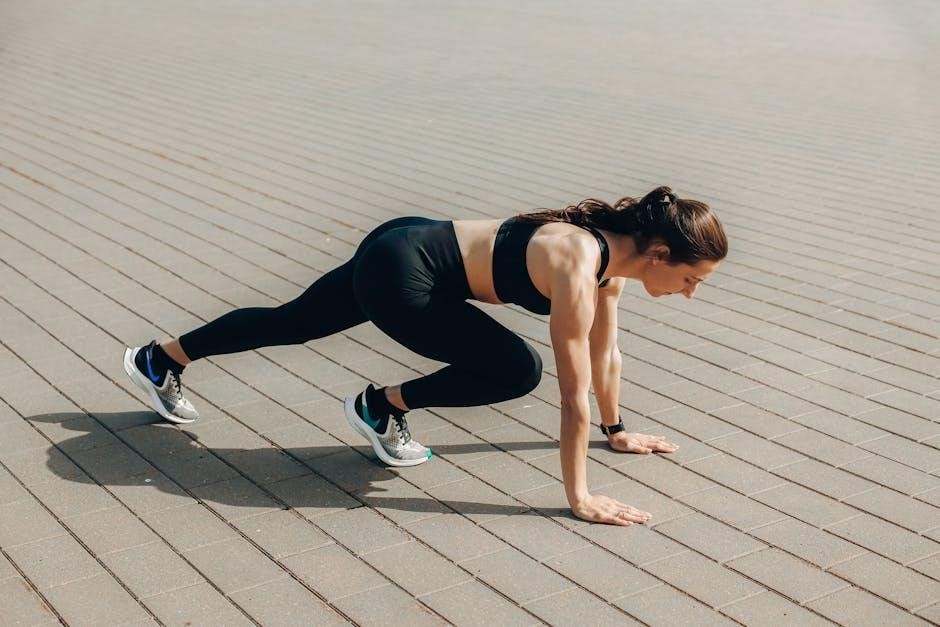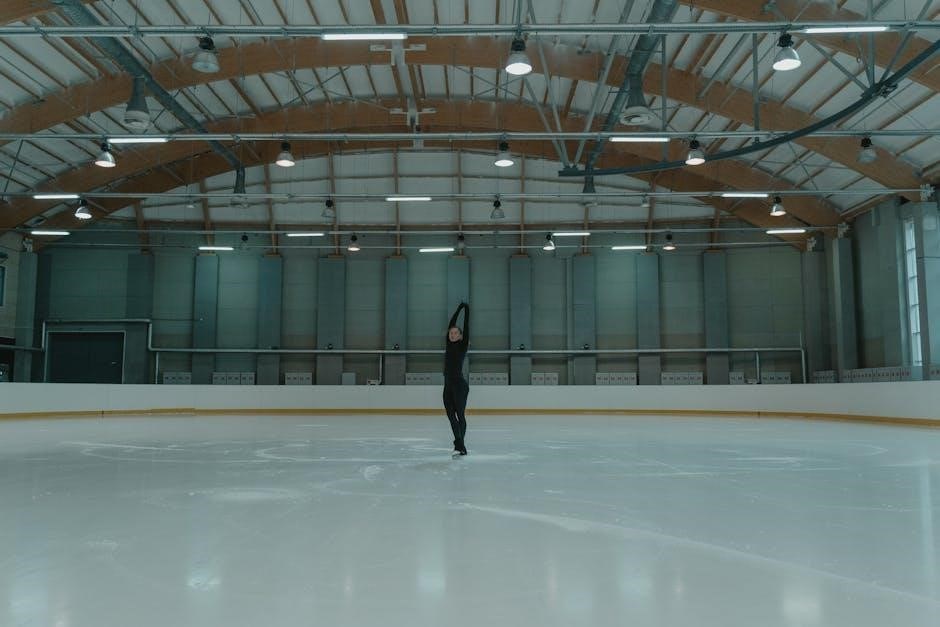Rotator cuff tendinitis is inflammation of the tendons in the shoulder, causing pain and limiting movement. It often results from overuse or repetitive strain. Exercises play a crucial role in rehabilitation, focusing on strengthening and improving flexibility to restore shoulder function and reduce discomfort.
1.1 Understanding the Condition
Rotator cuff tendinitis refers to inflammation of the tendons in the shoulder’s rotator cuff, often caused by overuse, repetitive motions, or acute injury. It leads to pain, stiffness, and limited mobility. The rotator cuff consists of four muscles and tendons that stabilize the shoulder joint. If left untreated, tendinitis can progress to partial or complete tears. Early diagnosis and treatment, including targeted exercises, are crucial to prevent further damage and restore shoulder function. Understanding the condition is key to effective management and recovery.
1.2 Importance of Exercise in Rehabilitation
Exercise is fundamental in rehabilitating rotator cuff tendinitis, as it restores shoulder mobility, strength, and stability. Targeted exercises enhance flexibility, strengthen the rotator cuff muscles, and improve joint stability. Regular exercise also reduces pain and inflammation, preventing further injury. Consistency in performing these exercises is crucial for restoring normal shoulder function and ensuring long-term recovery. A well-structured exercise program can help individuals return to daily activities and maintain shoulder health effectively.
Types of Rotator Cuff Tendinitis Exercises
Exercises for rotator cuff tendinitis include stretching, strengthening, and stability/proprioception exercises. These target improved flexibility, muscle strength, and joint stability to promote recovery and prevent further injury.
2.1 Stretching Exercises
Stretching exercises are essential for improving shoulder flexibility and reducing stiffness. Common stretches include the doorway stretch, which targets the anterior shoulder, and the shoulder flexion stretch, performed overhead with a dowel. These exercises help restore range of motion, alleviate tightness, and prepare the shoulder for strengthening workouts. Regular stretching can enhance recovery and prevent further injury by maintaining joint mobility and reducing tendon strain. Consistency is key for optimal results in rehabilitation.
2.2 Strengthening Exercises
Strengthening exercises are vital for rebuilding the rotator cuff muscles, improving stability, and preventing future injuries. Common exercises include internal and external rotations with elastic resistance bands, targeting the supraspinatus and teres minor muscles. Scapular punches and rows also enhance shoulder stability. These exercises should be performed with controlled movements, focusing on proper form to avoid strain. Strengthening improves joint support and promotes long-term recovery, helping patients regain functional strength and mobility in their shoulders.
2.3 Stability and Proprioception Exercises
Stability and proprioception exercises target the muscles around the shoulder, enhancing balance and awareness. These include scapular range of motion drills, which involve shrugging and squeezing shoulder blades. Isometric shoulder external rotations in a doorway strengthen stabilizing muscles without movement. Proprioceptive exercises, like single-arm stands on unstable surfaces, improve joint position sense. These exercises restore dynamic stability, reducing the risk of re-injury and improving overall shoulder function. They are often performed with minimal equipment, making them ideal for home rehabilitation programs.
Recommended Stretching Exercises
Stretching exercises improve flexibility and reduce stiffness in the shoulder. Doorway stretches and shoulder flexion with a dowel are effective for enhancing range of motion and relieving tension.
3.1 Doorway Stretch
The doorway stretch is a popular exercise for improving shoulder flexibility. Stand in a doorway with your hands on the doorframe at shoulder height, palms forward. Place one foot forward slightly and lean forward gently until you feel a stretch in your shoulders. Hold for 30 seconds and repeat on both sides. Perform 3 sets, 2-3 times daily, to enhance range of motion and reduce stiffness.
3.2 Shoulder Flexion Overhead with Dowel
Hold a dowel or stick with both hands, shoulder-width apart, palms forward. Slowly raise the dowel overhead, keeping arms straight, and hold for 3 seconds. Lower the dowel to the starting position. Perform 10 repetitions and 3 sets. Focus on maintaining shoulder stability and avoiding shrugging. Start with a slow tempo to emphasize control and gradually increase speed as comfort allows. This exercise improves shoulder flexion and reduces stiffness in the rotator cuff muscles.
3.3 Wand Exercise for External Rotation
Lie on your back with the affected arm at your side, holding a wand or stick with palms up. Slowly rotate the wand outward, keeping the elbow at 90 degrees, until a gentle stretch is felt. Hold for 3 seconds, then return to the starting position. Perform 10 repetitions and 3 sets. This exercise enhances external rotation and reduces stiffness in the rotator cuff tendons. Progress gradually by increasing repetitions as strength improves.

Strengthening Exercises for the Rotator Cuff
Strengthening exercises focus on resistance bands, internal/external rotations, rows, and scapular punches to enhance shoulder stability and muscle endurance, reducing the risk of further injury.
4.1 Internal Rotation with Elastic Resistance Bands
Internal rotation with elastic resistance bands targets the rotator cuff muscles, improving strength and stability. Loop the band around a stable object and hold it with your elbow bent at 90 degrees. Slowly pull the band toward your stomach, keeping your upper arm still. Perform 3 sets of 10-15 repetitions. Avoid pain and focus on controlled movements to enhance shoulder function and reduce injury risk.
4.2 External Rotation with Elastic Resistance Bands
External rotation with elastic resistance bands strengthens the rotator cuff muscles, enhancing shoulder stability. Attach the band to a stable object and hold it with your elbow bent at 90 degrees; Slowly rotate your arm outward, keeping your upper arm still. Perform 3 sets of 10-15 repetitions. Focus on controlled movements and avoid pain to effectively target the muscles and improve shoulder function. This exercise helps prevent further injury and enhances mobility.
4.3 Rows and Scapular Punches
Rows and scapular punches target the muscles around the shoulder blade, improving posture and stability. For rows, hold a resistance band, pull it towards your chest, and squeeze your shoulder blades. For scapular punches, press the band forward while keeping your arms straight. Perform 3 sets of 10-15 repetitions. These exercises strengthen the rhomboids and trapezius, enhancing scapular stability and reducing shoulder strain. Focus on controlled movements to maximize effectiveness and prevent injury.
Stability and Proprioception Training
Stability and proprioception training enhances shoulder joint awareness and balance. Exercises like scapular range of motion and isometric external rotation improve control and reduce injury risk.
5.1 Scapular Range of Motion Exercises
Scapular range of motion exercises focus on improving flexibility and strength around the shoulder blades. These exercises include shrugging shoulders, squeezing shoulder blades, and relaxing. They help maintain proper shoulder mechanics and reduce stiffness. Perform 3 sets of 10 repetitions daily to enhance mobility and stability. Proper form is essential to avoid strain. These exercises are key for rehabilitation and can be done as part of a daily maintenance routine to support shoulder health and prevent further injury.
5.2 Isometric Shoulder External Rotation
Isometric shoulder external rotation strengthens the rotator cuff without moving the joint. Stand in a doorway with your elbow bent at 90 degrees and your hand pressing against the door frame. Press your hand outward into the frame, holding for 5 seconds. Perform 3 sets of 10 repetitions. This exercise improves stability and strength, reducing shoulder impingement. Avoid shrugging your shoulders during the movement to target the correct muscles effectively.

Creating a Rotator Cuff Exercise Routine
A well-structured exercise routine is essential for effective rehabilitation. It should include a balance of stretching, strengthening, and stability exercises, tailored to individual goals and progress.
6.1 Setting Goals and Repetitions
Setting clear goals and repetitions is vital for effective rehabilitation. Start with 3 sets of 10-15 repetitions for each exercise, gradually increasing as strength improves. Focus on pain-free movements, adjusting resistance or range as needed. Progress should be tracked weekly, ensuring exercises remain challenging yet manageable. A healthcare provider can help tailor these parameters to individual recovery needs and ensure a safe, progressive routine. Consistency and proper form are key to achieving long-term benefits.
6.2 Frequency and Duration of Sessions
For optimal recovery, exercises should be performed 3-4 times weekly, allowing rest days for muscle repair. Each session typically lasts 20-30 minutes, starting with gentle stretches and progressing to strengthening exercises. Consistency is key, as regular practice enhances muscle strength and joint stability. Begin with shorter sessions and gradually increase duration as endurance improves. Always prioritize proper form and pain-free movements to avoid setbacks and ensure steady progress in rehabilitation.
6.3 Warm-Up and Cool-Down Techniques
Begin with a 5-10 minute warm-up using light cardio or dynamic stretches to prepare the shoulder muscles. Arm circles, shoulder rolls, and gentle overhead reaches are effective. After exercises, cool down with static stretches like the doorway stretch or shoulder flexion to improve flexibility and reduce muscle tension. Hold stretches for 20-30 seconds and breathe deeply to relax. Proper warm-up and cool-down routines help prevent injury, enhance recovery, and maintain shoulder mobility. Consistency in these practices supports long-term rehabilitation success.
Additional Tips for Effective Rehabilitation
Monitor progress, stay hydrated, and consider anti-inflammatory diets to support healing. Regular monitoring ensures exercises are performed safely and effectively, promoting optimal recovery and strength restoration.
7.1 Proper Posture During Exercises
Maintaining proper posture during exercises is crucial for effective rehabilitation. Stand or sit upright to avoid straining other muscles. For example, during shoulder flexion, keep your spine neutral and engage your core to support movement. Poor posture can lead to improper form, potentially causing further injury or ineffective workouts. Use a mirror to monitor alignment and take regular breaks to adjust. Consistent attention to posture ensures exercises target the correct muscles, promoting healing and strengthening the rotator cuff effectively.
7.2 Avoiding Pain During Exercises
Avoiding pain during exercises is essential to prevent further injury. If pain occurs, stop the exercise immediately and consult your healthcare provider. Start slowly, easing into movements to avoid strain. Pain is a signal that something is wrong, and ignoring it can worsen the condition. Focus on gentle, controlled motions, and modify exercises to stay within a pain-free range. Prioritize comfort and progress gradually to ensure safe and effective rehabilitation.
7.3 Use of Resistance Bands and Equipment
Resistance bands are widely used for rotator cuff rehabilitation due to their portability and effectiveness. They provide gentle to moderate resistance, ideal for strengthening without overloading the shoulder. Start with lighter resistance and gradually increase as strength improves. Common exercises include internal rotation with the arm at the side and scapular punches. Proper form is crucial to avoid injury. Always consult your healthcare provider before beginning any new exercise program to ensure it suits your specific condition and needs.

Progression of Exercises
Exercises progress from basic mobility to intermediate strengthening and advanced stability. Each phase builds on the previous, ensuring gradual improvement in shoulder strength and function over time.
8.1 Phase 1: Basic Mobility and Strengthening
Phase 1 focuses on restoring basic shoulder mobility and introducing gentle strengthening exercises. Activities include passive stretching, isometric exercises, and low-resistance movements to avoid aggravating the injury. This phase aims to reduce stiffness, improve range of motion, and prepare the shoulder for more intense exercises in subsequent phases. It typically lasts 2-4 weeks, with exercises performed 2-3 times daily to establish a foundation for recovery and prevent further inflammation.
8.2 Phase 2: Intermediate Strengthening
Phase 2 introduces intermediate strengthening exercises to build upon the foundation established in Phase 1. Activities include resistance band exercises like internal and external rotations, rows, and scapular punches. These exercises aim to enhance shoulder stability and muscle endurance. They are performed with gradually increasing resistance and controlled movements, focusing on pain-free ranges. This phase typically lasts 4-6 weeks, with exercises done 3-4 times weekly to promote progressive strengthening without causing inflammation or discomfort.
8.3 Phase 3: Advanced Strengthening and Stability
Phase 3 focuses on advanced strengthening and stability exercises to restore full shoulder function. Activities include dynamic movements, such as plyometric drills and resisted exercises using high-resistance bands. Functional exercises mimicking daily tasks or sports-specific actions are introduced to improve coordination and strength. Sessions are typically 3-4 times weekly, with a focus on maintaining proper form and gradually increasing intensity to prevent recurrence of tendinitis and enhance overall shoulder stability and performance.

Common Mistakes to Avoid
Avoid overexertion and never ignore pain during exercises, as this can worsen the injury. Ensure proper technique and form to prevent further damage and promote effective healing.
9.1 Overexertion and Ignoring Pain
Overexertion during exercises can exacerbate rotator cuff tendinitis, leading to prolonged recovery. Ignoring pain signals may result in further injury or inflammation. It’s crucial to listen to your body and stop if discomfort arises. Gentle progression and pain-free movements are essential to avoid setbacks. Always prioritize controlled, moderate efforts to ensure safe and effective rehabilitation. Your healthcare provider can guide appropriate limits for your exercise routine, ensuring a balance between progress and protection of the shoulder joint.
9.2 Improper Technique and Form
Improper technique during exercises can worsen rotator cuff tendinitis, leading to further injury or prolonged recovery. Poor form may place unnecessary strain on the shoulder, causing inflammation or tendon irritation. It’s essential to maintain correct posture and movement patterns to target the right muscles effectively. Consulting a physical therapist can help ensure proper form, minimizing the risk of complications and optimizing rehabilitation outcomes. Avoiding common mistakes, like shrugging shoulders or using momentum, is critical for safe and effective exercise performance.

Recovery and Maintenance
Proper recovery involves rest, ice therapy, and gradual return to activities. Consistent exercise and avoiding overexertion are key to maintaining shoulder health and preventing recurrence.
10.1 Rest and Ice Therapy
Rest and ice therapy are essential for managing rotator cuff tendinitis. Rest allows the inflamed tendons to heal, while ice reduces swelling and alleviates pain. Applying ice for 15-20 minutes several times a day can significantly reduce inflammation. It’s important to avoid activities that aggravate the condition during the recovery phase. Proper rest and ice therapy, combined with prescribed exercises, help restore shoulder function and prevent further injury. Consistency in these practices ensures effective healing and long-term shoulder health.
10.2 Long-Term Maintenance Exercises
Long-term maintenance exercises are crucial for sustaining shoulder health after recovery. Incorporating exercises like shoulder flexion with a dowel and wand exercises for external rotation helps maintain strength and flexibility. Consistency is key to preventing recurrence. These exercises should be performed a few times a week to ensure continued muscle strength and joint mobility. Regular maintenance helps preserve shoulder function and reduces the risk of future injuries, promoting overall upper limb health and stability.

Resources for Rotator Cuff Tendinitis Exercises
Downloadable PDF guides and instructional videos provide detailed visuals and step-by-step instructions for performing rotator cuff exercises safely and effectively. These resources are invaluable for home rehabilitation programs.
11.1 Downloadable PDF Guides
Downloadable PDF guides offer comprehensive instructions and illustrations for rotator cuff exercises. These resources detail stretches, strengthening exercises, and proper techniques, making them ideal for home rehabilitation. Many PDFs include progress tracking, exercise schedules, and tips for avoiding injury. They serve as a convenient and accessible tool for individuals to follow structured programs, ensuring consistency and effectiveness in their recovery journey. These guides are often recommended by healthcare providers to supplement physical therapy routines.
11.2 Videos and Instructional Materials
Videos and instructional materials provide visual guidance for performing rotator cuff exercises correctly. They often include demonstrations by professionals, step-by-step instructions, and tips for maintaining proper form. These resources are particularly helpful for understanding complex movements and ensuring safety during workouts. Many websites and rehabilitation programs offer video libraries, making it easier for individuals to follow along at home. Additionally, instructional materials often complement downloadable PDF guides, offering a comprehensive approach to managing and recovering from rotator cuff tendinitis.
Preventing Recurrence
Regular exercise routines, ergonomic adjustments, and proper posture help maintain shoulder health and prevent future rotator cuff issues. Consistency is key to long-term prevention.
12.1 Regular Exercise Routine
A consistent exercise routine is essential for preventing rotator cuff recurrence. Incorporate stretching and strengthening exercises, such as shoulder flexion and external rotations, to maintain muscle balance. Regular activity helps improve joint stability and reduces inflammation. Aim to perform exercises 3-4 times weekly, focusing on proper form to avoid strain. Over time, this routine strengthens the muscles, enhancing shoulder function and minimizing the risk of future injuries or tendinitis flare-ups.
12.2 Ergonomic Adjustments and Posture
Proper ergonomic adjustments and posture are vital for preventing rotator cuff tendinitis recurrence. Ensure workspace setup minimizes shoulder strain, with monitors at eye level and arms resting at sides. Avoid slouching or reaching overhead frequently. Strengthening core and shoulder muscles through exercises improves posture, reducing tendon stress. Regular breaks and stretching can also alleviate strain, promoting long-term shoulder health and preventing inflammation caused by poor alignment or repetitive movements.
The Role of Physical Therapy
Physical therapy provides customized exercise programs tailored to individual needs, focusing on strengthening and flexibility. Therapists monitor progress, ensuring proper form and adjusting routines as needed.
13.1 Customized Exercise Programs
Customized exercise programs are designed to address specific rotator cuff injuries, focusing on strengthening and improving flexibility. These programs typically include a mix of stretching, strengthening, and stability exercises tailored to the individual’s needs. Physical therapists create personalized routines to target affected muscles, ensuring proper form and technique. Regular assessments allow adjustments to maintain progress and prevent further injury, promoting a full recovery and restoring shoulder function effectively.
13.2 Monitoring Progress and Adjustments
Monitoring progress is essential for effective rehabilitation. Regular assessments by physical therapists ensure exercises are effective and safe. Adjustments are made based on individual improvement, pain levels, and functional goals. This iterative process helps refine the exercise program, preventing plateaus and enhancing recovery. Open communication between patient and therapist fosters a tailored approach, optimizing outcomes and ensuring a smooth transition through rehabilitation phases.

Importance of Consistency
Consistency in performing rotator cuff exercises is vital for long-term healing and preventing recurrence. Regular routines strengthen muscles, improve function, and maintain shoulder health, ensuring sustained recovery and stability.
14.1 Long-Term Benefits of Regular Exercise
Regular exercise for rotator cuff tendinitis offers numerous long-term benefits, including enhanced shoulder stability, improved joint mobility, and strengthened muscles. Consistent routines reduce the risk of recurrence, promote faster recovery, and restore functional abilities. Over time, these exercises help prevent future injuries, maintain proper posture, and ensure optimal shoulder health, allowing individuals to engage in daily activities and sports without discomfort or limitation. Commitment to regular exercise is essential for achieving and sustaining these benefits.
14.2 Motivation and Adherence Strategies
Maintaining motivation for rotator cuff exercises requires setting clear, achievable goals and tracking progress. Using visual aids like PDF guides or videos can help clarify proper form and technique. Incorporating variety in routines and seeking support from physical therapists or support groups enhances engagement. Celebrating small milestones boosts morale, while reminders of long-term benefits, such as pain reduction and improved function, help sustain commitment. Consistency is key to maximizing the effectiveness of the rehabilitation process and preventing relapse.
